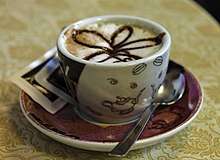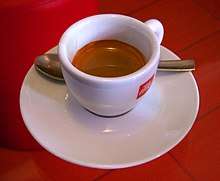Italian meal structure
Italian meal structure is typical of the Mediterranean region and different from meal structure of Northern Europe / Northwestern Europe and Germanic and Slavic Europe, though it still often consists of breakfast, lunch, and supper. However, much less emphasis is placed on breakfast, and breakfast itself is often skipped or involves lighter meal portions than are seen in other non-Mediterranean Western countries. Late-morning and mid-afternoon snacks, called merenda (plural merende), are also often included in this meal structure. Italians also commonly divide a celebratory meal into several different courses.
| Italian cuisine |
|---|
|
|
Daytime meal structure
Breakfast (Colazione)

Italian breakfast (prima colazione) consists of caffè latte (hot milk with coffee) or coffee with bread or rolls, butter and jam. A cookie-like rusk hard bread, called fette biscottate, and cookies are commonly eaten. Children drink caffè d'orzo, hot chocolate, plain milk, or hot milk with very little coffee. If breakfast is eaten in a bar (coffee shop), it is composed of cappuccino and cornetto or espresso and pastry. Other products, such as breakfast cereals, fruit salad (macedonia), muesli and yogurt, are becoming increasingly common as part of the meal. However, Italian breakfasts vary by region and by season. In some regions, such as Tuscany and Umbria, in the past, people used to drink red wine (notably Chianti) into which they would dip their biscuits. Uovo sbattuto is another ubiquitous Italian breakfast item that utilizes egg and sugar and sometimes served atop caffè. It is also very common for Italians to have a quick breakfast snack during the middle of the morning (typically a tramezzino or bread roll).
Lunch (Pranzo)
Lunch is usually regarded as the most important meal. Most shops close for the pausa pranzo (lunch break) between 13:00 and 15:00. In most schools, children are given a lunch break when they can go home for lunch, or eat at the school cafeteria, or eat a packed lunch. Since the introduction of fast foods, takeaways and frozen and tinned foods, Italians tend to eat less home-made food but fresh food is still quite common and most people buy bread, milk and other foods daily. Many adults still make their own food (e.g., tomato sauce from their own tomatoes) and takeaways are not very frequent. A typical Italian lunch consists of a first course il primo (pasta, rice or similar), a second-course il secondo (meat or fish) served together with a side dish il contorno (vegetable or salad), fruit, dessert and coffee.
Commuters and other workers tend to eat less often at home but instead, have a quick meal in a restaurant or pizzeria. Many foreign fast-food chains operate in Italy, especially in big cities and along motorways. Italian fast-food chains, like Autogrill, are also prevalent, often featuring versions of local dishes.
Mid-afternoon snack (Merenda)
Many children and adults have a mid-afternoon snack called merenda, generally consumed after school or in mid-afternoon. This may include a wide variety of foods. Merenda is often similar to breakfast, and might consist of a hot milky drink with bread and honey/jam or brioches; other foods are also eaten, such as yogurt, gelato, granita, fruit salad (or just fruit), nuts, biscuits and cookies, cake, sweets, etc.
Supper (Cena)
For cena, people tend to eat sometimes a primo or a soup, sometimes a secondo.
Formal meal structure



A structure of an Italian meal in its full form, usually performed during festivities.[1]
- Aperitivo
- The aperitivo opens a meal, and it is similar to an appetizer. Most people gather around standing up and have alcoholic/non-alcoholic drinks such as wine, prosecco, spritz, vermouth, and gingerino. Occasionally small amounts of food are consumed, such as olives, crisps, nuts, cheese, sauce dips, little quiches or similar snacks.
- Antipasto
- The antipasto is a slightly heavier starter. It is usually cold and lighter than the first course. Examples of foods eaten are salumi (such as salame, mortadella, prosciutto, bresaola and other charcuterie products), cheeses, sandwich-like foods (panino, bruschetta, crostino), marinated vegetables or fish, cold salmon or prawn cocktails; more elaborate dishes are occasionally prepared.
- Primo
- A primo is the first course. It consists of hot food and is usually heavier than the antipasto, but lighter than the second course. Non-meat dishes are the staple of any primo piatto: examples are risotto, pasta, seafood or vegetarian sauces, soup and broth, gnocchi, polenta, crespelle, casseroles, or lasagne.
- Secondi
- This course may include different meats and types of fish, including turkey, sausage, pork, steak, stew, beef, zampone, salt cod, stockfish, salmon, lobster, lamb, chicken, or a roast. The primo or the secondo piatto may be considered more important depending on the locality and the situation.
- Contorno (side dish)
- A contorno is a side dish and it's commonly served alongside a secondo piatto. These usually consist of vegetables, raw or cooked, hot or cold. They are usually served on a separate dish, not on the same plate as the meat as in northern European style of presentation.
- Insalata
- If the contorno contained many leafy vegetables, the salad might be omitted. Otherwise, a fresh garden salad could be served at this point.
- Formaggi e frutta
- An entire course is dedicated to local cheeses and fresh seasonal fruit. The cheeses will be whatever is typical of the region (see List of Italian cheeses).
- Dolce
- Next follows the dolce, or dessert. Frequent dishes include tiramisu, panna cotta, cake or pie, panettone or pandoro (the last two are mainly served at Christmas time) and the Colomba Pasquale (an Easter cake). A gelato or a sorbetto can be eaten too. Though there are nationwide desserts, popular across Italy, many regions and cities have local specialties. In Naples, for instance, zeppole and rum baba are popular; in Sicily, cassata and cannoli are commonly consumed; mostarda, on the other hand, is more of a Northern dish.
- Caffè
- Coffee is often drunk at the end of a meal, even after the digestivo. Italians do not have milky coffees or drinks after meals (such as cappuccino or caffè macchiato), but strong coffee such as espresso, which is often drunk very quickly in small cups while still hot.
- Digestivo
- The digestivo, also called ammazzacaffè if served after the coffee, is the drink to conclude the meal. Drinks such as grappa, amaro, limoncello or other fruit/herbal drinks are drunk. Digestivo indicates that the drinks served at this time are meant to ease digestion of a long meal.
See also
References
- Mike Kiely (4 December 2010). "The structure of an Italian meal". Italiana. Retrieved 2014-03-02.